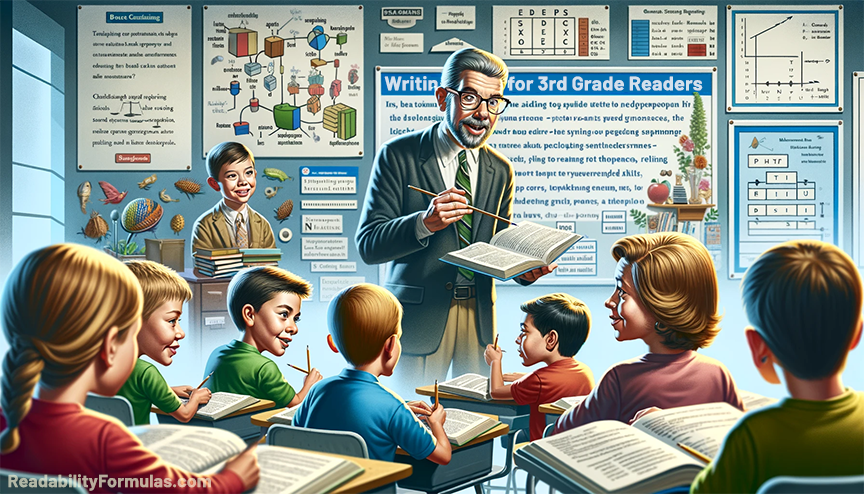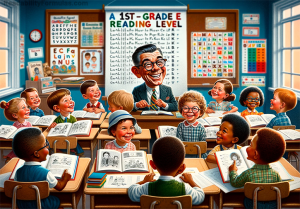 A 3rd-grade reading level means children in third grade, ages 8-9 years old. At this stage, students begin to progress from learning to read to reading to learn. Syntactics refer to the arrangement of words and phrases to create well-formed sentences. It includes rules that govern sentence structure, word order, punctuation, and grammar. In readability, syntactics play a role in making texts accessible and engaging.
A 3rd-grade reading level means children in third grade, ages 8-9 years old. At this stage, students begin to progress from learning to read to reading to learn. Syntactics refer to the arrangement of words and phrases to create well-formed sentences. It includes rules that govern sentence structure, word order, punctuation, and grammar. In readability, syntactics play a role in making texts accessible and engaging.
- Fluency: 3rd graders are expected to read with more fluency—this means reading at a good pace, with expression, and without many hesitations or errors. They can read 90-115 words per minute.
- Comprehension: They can understand what they read, connect their own experiences, and ask questions about the text. They can explain what happened in the beginning, middle, and end, and even guess what might happen next.
- Vocabulary: 3rd graders are expanding their vocabulary. They’ll begin to understand words from context clues. They’ll know around 3,000-4,000 words and can decode new words by looking at how the sentence uses them.
- Complex Text: They begin to read more complex texts, including chapter books, and can follow intricate plotlines. Their reading materials may include non-fiction texts that require them to comprehend and interpret information. They can read chapter books 30-50 pages long. These books include harder words and detailed plots. They can write different types of sentences, like statements, questions, and exclamations. They might write, “The cat is cute. Why is it hiding? Wow, look at it jump!”
- Writing Responses: Many 3rd graders can respond to what they read in writing—they can summarize a story, explain a character’s actions, or predict what might happen next.
- Descriptive Language: They use descriptive words and details in their sentences. Instead of “The car is big,” they might write, “The enormous red car has shiny wheels.”
- Word Decoding: By 3rd grade, students know phonics and can decode multisyllable words. They can break down bigger words into parts and sound them out. For example, they can read words like “playground” or “basketball.”
- Parts of Speech: They know nouns, verbs, adjectives, and adverbs. They might write, “The fluffy dog (adjective) quickly (adverb) ran (verb) to its bowl (noun).”
- Grammar and Sentence Structure: They are likely to understand complex sentences and the basic rules of grammar. For example, “He runs” instead of “He run.”
- Critical Thinking: Students start thinking more critically about what they read, including making inferences and understanding cause and effect.
WORD LENGTH
The average word length is 3 to 5 letters. Here’s why this average word length is appropriate:
- Familiarity: Many common 3rd grade words fall within this length, including high-frequency sight words.
- Decoding Skills: Third graders decode words of this length, especially if they follow common phonetic patterns.
- Introducing Complexity: This word length allows for some complexity without being overly challenging. They can include plurals, simple prefixes or suffixes, and common multi-syllable words.
- Content Alignment: This word length aligns with common content and themes, such as simple narratives, non-fiction texts about animals, science, or history, and early chapter books.
- Balance with Longer Words: Texts for 3rd graders should still include longer, more complex words.
VOCABULARY
A 3rd grader has a vocabulary size of 2,000 to 3,000 words. This includes:
- High-Frequency Words: Common words in the English language (50-60% of the text) in both reading and speaking.
- Content-Specific Vocabulary: Words in specific subjects such as science, social studies, or mathematics.
- Academic Vocabulary: Words used in educational settings but not in everyday conversation. Words like “compare,” “analyze,” or “evidence.”
- Literary Vocabulary: Words related to reading literature, such as “character,” “plot,” “setting,” etc.
READING RATES
- Beginning of 3rd Grade: Students start the year reading around 90-110 WPM.
- Middle of 3rd Grade: Many students progress to reading 100-120 WPM.
- End of 3rd Grade: By the end of 3rd grade, students read 110-130 WPM.
These rates apply to reading aloud. Silent reading rates may inflate, as reading aloud requires more processing for pronunciation and expression.
SENTENCES
- Simple Sentences: Most sentences are simple, about 60-70% of sentences ranging from 6 to 8 words in length.
- Compound Sentences: 20-30% of sentences are compound sentences in the 9 to 12-word range. These will use conjunctions like “and,” “but,” “or.”
- Complex Sentences: A smaller portion, around 10% of sentences, are complex, with 13 or more words. These include subordinating conjunctions, relative clauses, etc.
SENTENCE COMPLEXITY
- Simple Sentences: 50-60% of the sentences.
- Compound Sentences: 25-30% of the sentences.
- Complex Sentences: 10-15% of the sentences, with clear subordinate clauses.
SYLLABLES
- 1-Syllable Words: These high-frequency words make up 50-60% of the words.
- 2-Syllable Words: Two-syllable words are common and add complexity. Two-syllable words make up 25-30%.
- 3-Syllable Words: Many 3rd graders find three-syllable words accessible, though they can be more challenging. These words comprise 10-15% of the text.
- 4-or-More Syllable Words: You can include longer words with four or more syllables in moderation, around 5% of the text.
REPEAT WORDS vs. UNIQUE WORDS
When writing text for 3rd-grade readers, consider the percentages of repeat words and unique words.
- Repeat words can reinforce learning, especially for new vocabulary. Repeated words comprise 20-30% of the total word count. Examples: high-frequency words, sight words, or newly introduced vocabulary.
- Unique words add variety and interest. They help build vocabulary and enhance the reader’s language skills. 70-80% of the text consists of unique words, enriching the reading experience. Examples: content-specific terms, synonyms, and words that challenge the reader.
For example, a story about a family picnic will repeat the word “picnic” to emphasize the theme, while descriptive words (like “sunny,” “delicious,” “laughter”) will paint a vivid picture without repetition.
PASSIVE VS. ACTIVE VOICE
The choice between passive and active voice impacts readability and comprehension.
- 3rd grade readers prefer active voice, about 70-80% (or more) of the text.
- Passive voice makes up 20-30% of the text, used in specific contexts where it adds value or is contextually appropriate.
Active voice promotes better comprehension because of its clear and direct sentence structure.
PARAGRAPH LENGTH
- Short Paragraphs: 2-5 sentences per paragraph. Short paragraphs help maintain interest and make the text look less confusing.
- Moderate Paragraphs: 6-8 sentences is suitable for complex ideas or detailed descriptions.
Short and well-structured paragraphs align with the attention span and comprehension level of 3rd graders.
PARTS OF SPEECH
Third graders learn parts 0f speech to create more complex sentences and to understand different sentence structures. Their texts usually include the following percentages:
- Nouns: 20-25% of the words. Includes proper, common, and abstract nouns.
- Pronouns: 5-10% of the words. Such as personal, possessive, and reflexive pronouns.
- Verbs: 15-20% of the words. Includes action verbs, linking verbs, and helping verbs in various tenses.
- Adjectives: 5-10% of the words. Descriptive words, including comparative and superlative forms.
- Adverbs: 4-6% of the words. Describing how, when, or where an action occurs.
- Prepositions: 8-12% of the words. Words that show location, direction, or time.
- Conjunctions: 2-5% of the words. Includes coordinating and subordinating conjunctions.
- Interjections: Less than 1%. Expressive words used sparingly.
PUNCTUATION
- Periods: 60-70% of sentences to denote the end of a statement.
- Commas: 30-40% of sentences, often for listing or separating clauses.
- Question Marks: 5-10% of sentences, depending on the text’s nature (e.g., more in an instructional or interactive text).
- Exclamation Points: 2-5% of sentences might end with an exclamation point to convey excitement or emphasis.
- Quotation Marks: 10-20% of a narrative text to indicate dialogue.
- Apostrophes: 5-10% of words might include apostrophes for contractions or possessive forms.
- Colons and Semi-Colons: Rare in 3rd-grade texts, less than 1%, and usually introduced with explanations.
- Hyphens and Dashes: Used sparingly, 1-2% in compound words or for emphasis.
Writing for 3rd-grade readers is a rewarding and engaging experience. This age group is curious, imaginative, and beginning to develop more complex reading skills.






